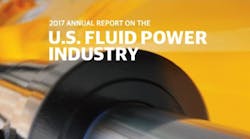Fluid power is a workhorse of the U.S. economy—a cross-cutting technology of choice for dozens of industries and hundreds of applications. That’s one of the many conclusions in the new Annual Report on the U.S. Fluid Power Industry, published by the National Fluid Power Association. The report reviews both the size and economic impact of the industry, as well as explores the energy consumption, best practices, and current R&D directions of fluid power technology.
The information provided in the report is useful to fluid power professionals, buyers, and prospects. Key conclusions include:
- U.S. manufacturing of fluid power components reached a record-high $21.7 billion in 2017.
- Fluid power exports continue to increase since recession-era lows, reaching customers around the globe.
- The supply, manufacturing, and distribution of fluid power products directly employs more than 67,000 people and indirectly supports jobs for 775,000 more.
- And many more...
NFPA’s 2017 Annual Report on the U.S. Fluid Power Industry includes an overview of the fluid power industry and showcases fluid power as a workhorse of the American economy. Right now, this report is being used throughout dozens of companies to make inside sales, promote marketing efforts, and prepare strategic planning initiatives. It is also the most recent collection of data about the fluid power industry in areas such as shipments, percentage of industry growth, and a look into the future of the industry. Use this resource to compare your company data and see just how U.S. manufacturing of fluid power components reached a record-high $21.7 billion last year.
Download the report by clicking here.


